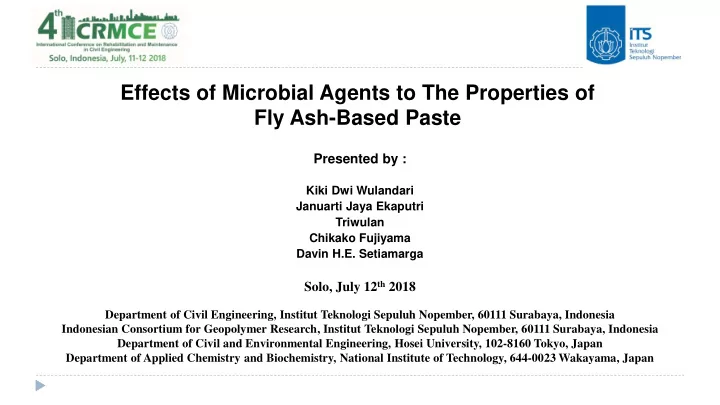

Effects of Microbial Agents to The Properties of Fly Ash-Based Paste Presented by : Kiki Dwi Wulandari Januarti Jaya Ekaputri Triwulan Chikako Fujiyama Davin H.E. Setiamarga Solo, July 12 th 2018 Department of Civil Engineering, Institut Teknologi Sepuluh Nopember, 60111 Surabaya, Indonesia Indonesian Consortium for Geopolymer Research, Institut Teknologi Sepuluh Nopember, 60111 Surabaya, Indonesia Department of Civil and Environmental Engineering, Hosei University, 102-8160 Tokyo, Japan Department of Applied Chemistry and Biochemistry, National Institute of Technology, 644-0023 Wakayama, Japan
Introduction Microorganisms, including bacteria, fungi, and algae, responsible for the production of biominerals such as carbonate, silicate, and calcium phosphate. Bio-mineralization is the approach of biotechnology to increase the properties of cement-based materials . 2
Introduction GEOPOLYMER PASTE CEMENT PASTE MICROBES FLY ASH-BASED PASTE SPECIFIC POROSITY COMPRESSIVE SEM ANALYSIS GRAVITY TEST TEST STRENGTH TEST XRD ANALYSIS 3
Materials FLY ASH SURALAYA CLASS F OPC AQUADES SODIUM SILICATE SODIUM HYDROXIDE Alkali Activator : MICROBIAL AGENT Four molars of sodium hydroxide and the mass ratio of sodium silicate to sodium hydroxide was 2. 4
Mix Proportions Cylinder 5 cm x 10 cm Alkali Microbial Mixtures Fly Ash OPC W/C Ratio Activator Agent P 35 % 65 % - - - PB 35 % 65 % - - 400 ml/m 3 Moist Curing C - 65 % 35 % 0.3 - CB - 65 % 35 % 0.3 400 ml/m 3 5
Test Methods COMPRESSIVE STRENGTH TEST XRD ANALYSIS SPECIFIC GRAVITY TEST SEM ANALYSIS POROSITY TEST 6
Results and Discussions XRD Analysis Oxides P PB Oxides C CB Mullite Mullite 41.6 % 32.8 % 38.9 % 27.5 % (Al 2 SiO 4 ) (Al 2 SiO 4 ) Zeolite T obermorite 31.7 % 38.7 % 32.3 % 36.4 % (Al 3 NaH 12 KO 22 Si 5 ) (Ca 3 HO 9 Si 3 ) Calcite Calcite 7.9 % 14.7 % 14.0 % 26.0 % (CaCO 3 ) (CaCO 3 ) Quartz Quartz 14.8 % 13.8 % 9.9 % 9.0 % (SiO 2 ) (SiO 2 ) Rutile 4.0 % 0.1 % 4.9 % 1.1 % Rutile (TiO 2 ) (TiO 2 ) The rising calcite contents were influenced by the adding of microbes in to the paste. As the microbes, bacteria produce the calcite as the result of metabolism process. 7
Results and Discussions Compressive Strength The adding of microbes influenced the compressive strengths of the fly-ash based paste. 8
Results and Discussions Specific Gravities Spesific gravities were not influenced by the adding of microbes in to the mixtures. 9
Results and Discussions Porosity Opened porosity higher than closed porosity, at all mixtures. Closed porosity of the paste with microbes show higher amount than the opposite paste. Closed porosity related with the behaviour of fly ash- based paste’s microstructures. 10
Results and Discussions The relationships between compressive strengths, calcite amounts, and closed porosity The increasing of compressive strengths were influenced by the amount of closed porosity and calcites in the fly ash-based paste. The rising of calcite were caused by microbial activity. The calcite fill the pores in the paste and influenced the compressive strength. 11
Results and Discussions SEM Analysis Hyphae as the result of yeast from fungi are visible, but bacteria are not obviously by this observation. 12
Conclusions 1. The utilization of microbial agent to the fly ash-based paste has brought enhancement to the properties even though the number of addition is small. 2. Microbial agent affected the properties of fly ash-based paste, according to the content of calcite by XRD, its compressive strength, and its porosity. 3. The compressive strength were influenced by the amount of calcite and porosity of fly ash-based paste. 4. Fly ash can be used to produce a high quality, but environmental friendly construction material when it ’ s mixed together with useful microbial agents. 13
Thank You 14
Recommend
More recommend